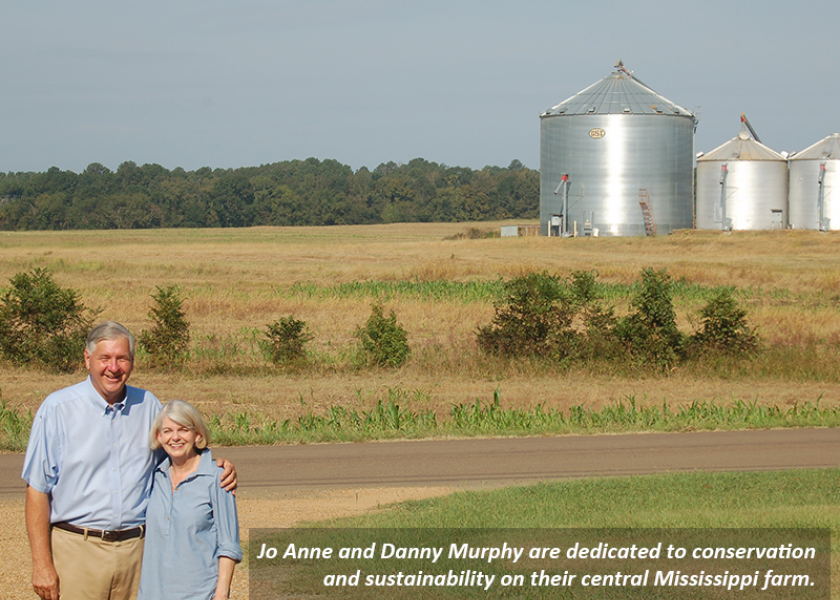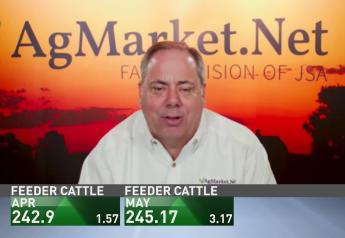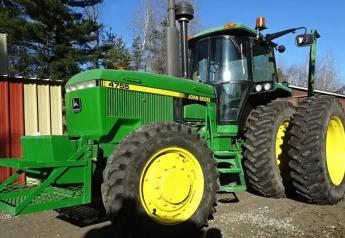Continuing the Journey

Stewardship takes another step forward as Danny Murphy lives out a conservation legacy that spans more than seven decades.
When Danny Murphy’s grandfather purchased his Mississippi farm in 1944, he knew it would have to be improved for him to be successful.
“His neighbors told him the land was very poor and only fit to hold the world together,” Danny explains.
Challenged by what he could do to make the land productive, over the years, the elder Murphy worked to establish a foundation of conserving and protecting both soil and water. It’s a foundation his grandsons, Danny and Tommy, continue to build on today.
Building on the Foundation
From the mid-1940s through the mid-2000s, cotton was king on Murphy Farms, located near the town of Canton. While Grandpa Murphy planted cover crops, built terraces and improved soil fertility, a successful and productive farm emerged.
“Cotton is a very difficult crop to get out of the ground,” Danny explains. “It’s got a weak seedling. One of the things (Grandpa) would always say was: ‘The rougher the land, the better the stand.’ I think he always thought if you didn’t limit tillage and make sure that you had the opportunity to have a little bit of organic matter, a little bit of structure to the ground, that it would get
a better stand.”
In the early ‘70s and into the early ‘80s, Danny says weed control in cotton was a real challenge, and the best way to combat that was with cultivation. The repeated soil-working process was disturbing, though, he adds.
Then in 2000, Danny says reniform nematode and low soil organic matter brought sub-par cotton yield. Corn helped solve both problems and through 2006, the Murphys maintained a three-way rotation between soybeans, corn and cotton.
But, as cotton prices dropped and corn and soybean prices increased, cotton slipped from the farm’s rotation.
With conventional tillage practices commonplace across the South, the operation moved to minimum-till in 1996, as Roundup Ready crops became available, greatly reducing soil erosion, Danny says.
The operation further converted to no-till in 2007, spurred by what Danny says was a feeling they could still do more to protect the soil.
“Yields were consistent with our tilled fields; plus, we were able to reduce fuel, labor and equipment,” Danny says. “By 2012, we made the full transition to 100% no-till. Now that we have up to 14 crop seasons on some of our acreage, we continue to see the benefits of no-till production and adding cover crops.”
Additionally, Danny says soil organic matter has improved from below 1% to between 1.4% and 1.9%. Working with their local Natural Resources Conservation Service, the Murphys are further able to continue looking for ways to conserve and improve farmland.
Located in central Mississippi, 2% to 6% slopes are found along the rolling hills of the Murphy farm. Highly erodible land, formed from wind-blown soil deposits called loess, is common in the region. Average rainfall exceeds 50 inches per year.
“The combination of highly erodible soil and high rainfall creates an environment which responds to our no-till production system,” Danny explains.
Terraces were first introduced to the Murphy operation in the 1950s, although many have been constructed after Danny started farming.
“With our long slopes and highly erodible soil, terraces are essential to
reducing erosion on our fields,” Danny says. “We do use grass waterways and have our turn rows in grass sod to filter the water of sediment, fertilizer and pesticides before it leaves our field.”
Following terraces, planting takes place on the contour. He says rock chutes—where field ditches drain into larger, deeper ditches—are also continually added to the operation to help eliminate what he calls “eat back” from field ditches into the acreage.
Murphy says it’s interesting to see the effects no-till has on soil organic matter and adds that the best seedbed is the one nature prepares.
“Back when we were really cultivating the cotton ground, the organic matter in our soil tests would be 6/10ths or 7/10ths of 1%, really low,” Danny says. “When I did samples last fall, the lowest
one was 1.3% and up to about 1.8%. So, I think if we continue to incorporate cover crops, we can build that organic matter up to 2% on most of the farm. Soil organic matter does so much for water-holding capacity and water intake and limits erosion.”
From the Ground Up
Cover crops are key to the Murphys’ conservation efforts with wheat, black oats or cereal rye seeded on about 50% of the acreage, mostly after a corn crop on acres that will transition to soybeans.
Because weed control normally begins on corn ground in mid-to-late February, Danny says the timing doesn’t allow ample opportunity for a cover crop to grow before corn.
“We are seeing benefits to the cover crops,” Danny says. “It’s helping build organic matter, and it seems that a mat created by a good growth of a cover crop aids in weed control. We will continue to experiment, hoping to find the right species of cover crop and planting time for a cover crop before corn.”
Though challenged in determining what varieties will be most effective, looking to the future, Danny says he is now ready to fine-tune their production plan to additionally benefit from cover crops.
“I think cover crops were something we were missing early on,” he says. “We weren’t doing that as much then, and now we’ve been doing more the last five years. Soybeans work well with a cover crop.”
Always striving to increase his conservation efforts, Danny learned recently of a five-way cover crop mixture that aimed to grow 10 tons of green matter over the winter before spring planting.
“That’s really fascinating to me to think about what we might do to get that and what it might mean for our summer crops with corn and soybeans,” he says.
Danny furthers stewardship efforts by planting wildlife food plots in the summer and winter. Installing pollinator and monarch plots, leaving standing crops and using Conservation Reserve Program acres as well as tree lines and woods to provide shelter and habitat for deer, turkey, rabbits and dove solidify the farm’s commitment to the environment.

“To me, sustainability is a continuous journey, producing crops and doing your best to minimize impacts on the environment and conserving our natural resources,” he says.
Yet, in a day and time when protecting the bottom line is paramount, finding a balance between profitability and land stewardship can be challenging for some farmers. For Danny, though, conservation has made a home on the operation’s balance sheet.
“Our no-till production system was a huge step in our sustainability journey, enabling us to reduce labor, diesel fuel, equipment and reduce soil erosion,” Danny says. “We want to make sure that we’re getting a return out of any input we put into the crop. Sustainability and conservation efforts really start with profitability. If you’re not profitable, you can’t be sustainable.”
Living Out a Conservation Legacy
When his grandfather purchased the family farm more than 75 years ago, Danny says he laid the groundwork for the operation’s success with conservation and land stewardship. His father continued
those efforts, and now Danny and his brother Tommy work to advance them.
While neither Danny nor Tommy have children interested in farming, the brothers are hopeful the conservation legacy their family has built can press on in the future.
“There are several young farmers in the area, and we’ll have to find one that wants to no-till the land,” Danny says. “I would like to make sure that continues and that they want to take care of the land. That will be an important part of our decision when we look for a renter down the road.”
As Danny and Tommy Murphy live out the family’s conservation legacy, they don’t stop short of sharing their success story with others.
“We try to work with our neighbors to reduce any anxiety they might have about our farming practices,” Danny explains. “I have presented programs on farming and farm issues to local service clubs and provided tours for our county leadership training.”
With nearly 50 years of farming under his belt, Danny is a pillar of conservation accomplishments. He has twice been the state winner in the no-till category of the National Corn Growers Association Yield Contest and was selected as the Mississippi Farmer of the Year by the Sunbelt Expo. He also served 10 years on the American Soybean Association Board of Directors and was elected president in 2013.
As the Mississippi farm team lead for the Farm Journal Foundation, Danny works on local nutrition and food security issues as well as global agriculture development. He says the Foundation’s overall
mission is to reduce hunger around the world and to assist farmers in those areas with the necessary tools to guide their own food production efforts.
“It’s important to me to help feed people,” Danny says. “That’s what a farmer’s job is, and in so many parts of the world, farmers need some additional help.”








